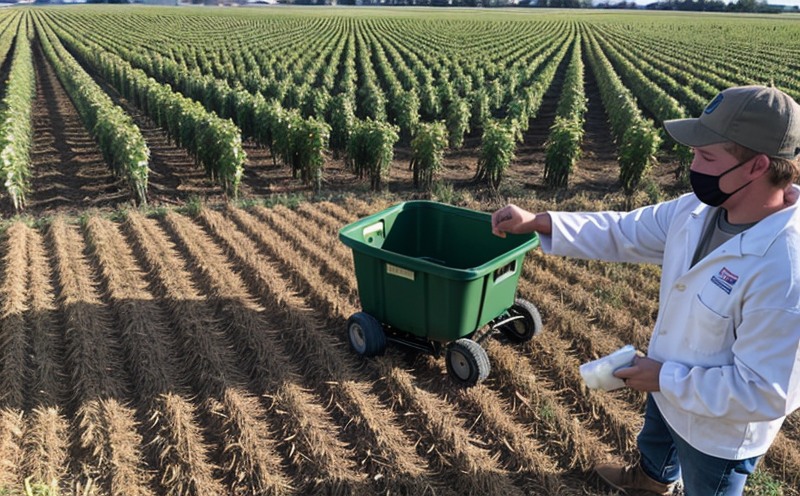Color Measurement Testing in Fruits & Vegetables
In the agricultural and forestry sectors, color measurement testing of fruits and vegetables is a critical component of ensuring product quality and consistency. Color can significantly impact consumer preference and shelf life, making it essential for producers to maintain consistent color standards throughout their supply chain.
The process begins with sample preparation, where fruits and vegetables are carefully selected based on size, shape, and maturity. These samples are then processed according to specific protocols to ensure that they represent the true color characteristics of the produce. Instruments used in this testing include spectrophotometers and colorimeters, which provide precise measurements of hue, saturation, and lightness.
The accuracy and reliability of these instruments are crucial for ensuring consistent results across batches and locations. Calibration is performed using standard reference materials to ensure that the instrument readings reflect real-world conditions accurately. This calibration process ensures that all tests conducted within the laboratory meet international standards such as ISO 13655:2018, which provides guidelines for color measurement in textiles.
Once calibrated, the instruments can measure the exact color parameters of each specimen. These measurements are then recorded and analyzed to identify trends and deviations from expected values. Deviations may indicate issues with growing conditions, handling practices, or processing methods that need addressing. By identifying these areas early on, producers can take corrective actions to improve product quality.
The results of the color measurement testing play a vital role in decision-making processes within agricultural operations. Farmers and processors use this information to optimize planting schedules, adjust irrigation levels, and refine harvesting techniques. Additionally, it helps in selecting appropriate packaging materials that enhance the visual appeal of the produce without compromising its freshness.
Accurate color measurement also supports compliance with regulatory requirements set forth by various governmental bodies worldwide. For instance, European Union regulations mandate specific color ranges for certain fruits and vegetables to ensure food safety standards are met. By adhering to these guidelines through rigorous testing protocols, companies can avoid potential legal issues associated with non-compliance.
Moreover, color measurement tests contribute significantly towards enhancing customer satisfaction by delivering high-quality products that meet consumer expectations consistently. Consumers increasingly demand transparency about where their food comes from and how it is produced, making accurate documentation of each step in the production process essential for building trust between producers and consumers.
Scope and Methodology
| Aspect | Description |
|---|---|
| Sample Preparation | Fruits and vegetables are selected based on size, shape, and maturity. They undergo standard procedures to ensure they accurately represent the produce’s color characteristics. |
| Instruments Used | Spectrophotometers and colorimeters measure hue, saturation, and lightness with high precision. |
| Calibration | The instruments are calibrated using standard reference materials to ensure accurate readings reflecting real-world conditions. |
| Data Collection | Measurements of hue, saturation, and lightness are recorded meticulously for analysis. |
| Analysis | Trends and deviations from expected values are identified to inform necessary adjustments in growing and processing practices. |
Quality and Reliability Assurance
Ensuring the highest level of quality and reliability is paramount when it comes to color measurement testing for fruits and vegetables. Our laboratories adhere strictly to international standards such as ISO 13655:2018, which provides comprehensive guidelines for color measurement in textiles but can be adapted for agricultural products.
We employ advanced technology and experienced personnel who maintain rigorous quality control measures throughout every stage of the testing process. This includes regular calibration checks to guarantee that all instruments remain accurate over time. Additionally, we conduct internal audits periodically to verify compliance with established procedures and ensure continuous improvement in our services.
The reliability of these tests directly impacts downstream processes within agricultural operations. Accurate color measurements enable farmers and processors to make informed decisions about various aspects of their operations. For example, they can adjust irrigation levels based on the results of color measurement tests to optimize water usage while maintaining optimal growing conditions.
Furthermore, reliable color measurement data supports compliance with regulatory requirements set forth by governmental bodies worldwide. By adhering strictly to these guidelines through robust testing protocols, companies can avoid potential legal issues associated with non-compliance and maintain their reputation for producing safe, high-quality products.
Customer Impact and Satisfaction
The results of color measurement tests have a direct impact on customer satisfaction by delivering consistently high-quality produce that meets consumer expectations. Accurate documentation of each step in the production process builds trust between producers and consumers, fostering long-term relationships.
For instance, some fruits and vegetables are known for having distinct color patterns that vary slightly depending on factors like ripeness or environmental conditions. By measuring these colors precisely using our advanced instruments, we help ensure that each batch meets the desired aesthetic standards set by both producers and consumers alike.
Our comprehensive approach to color measurement testing also helps enhance customer satisfaction further by providing detailed reports that outline all relevant information about the tested samples. These reports serve as valuable tools for decision-makers within agricultural operations, enabling them to identify areas where improvements can be made in order to optimize their processes continuously.





